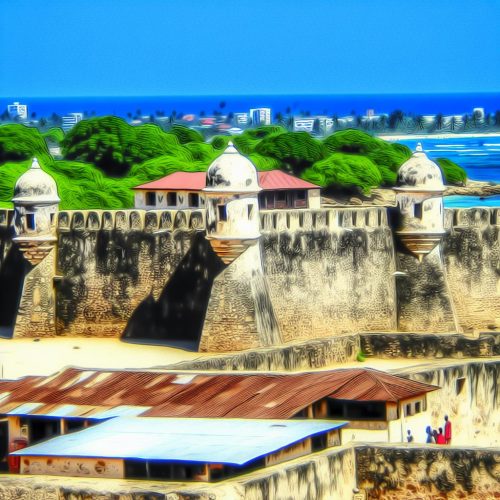Introduction
Located in the coastal city of Mombasa, Kenya, Fort Jesus stands as a monumental example of 16th-century Portuguese military architecture. This historical fortification was built to protect the port of Mombasa, which was then a key location on the Eastern African coast for trade and military strategy. Over time, Fort Jesus has transcended its original purpose and become a treasured UNESCO World Heritage Site, symbolizing not only the region’s rich history but also the intersections of different cultures and civilizations.
Historical Background
The construction of Fort Jesus took place between 1593 and 1596 under the auspices of the Portuguese, directed by the Italian architect Giovanni Battista Cairati. Built during a period of intense maritime rivalry, the fort was strategically designed to secure Portuguese interests within the Indian Ocean trade routes. This ambition for control was indicative of the broader European colonial endeavors during that era. The fort’s history is marked by a series of sieges and exchanges of control, which provide a vivid reflection of the larger narrative of colonial ambitions and conflicts in the region.
During its time, Fort Jesus was involved in numerous confrontations, initially between the Portuguese and the Omani Arabs, later involving other imperial powers such as the British. Each power that took control of the fort left its mark, adding layers to its historical and cultural significance. This complex history is instrumental in understanding the broader patterns of colonization and trade that influenced the region.
Architectural Design
The architectural design of Fort Jesus is emblematic of the cultural interactions that took place in the region during the colonial period. Giovanni Battista Cairati infused both European and local design elements to reflect the fusion of different cultures. The resulting architectural style is a blend of Portuguese, Arab, and Swahili influences, which are evident in the robust defensive structures and intricately designed interiors.
The fort is laid out in a quadrangular plan with four principal bastions known as São Filipe, Santiago, São Alberto, and São Matias. Each bastion played a critical role in the fort’s defense mechanism, representing a different aspect of the strategic military architecture of the time. The angular bastions were designed to provide defensive strength against naval attacks, which were a common threat given Mombasa’s strategic position along the Indian Ocean.
Role in Trade and Conflict
Fort Jesus’s significance extends beyond its military architecture; it was also a crucial node in the Indian Ocean trade network. The fort served as a control point for the exchange of various goods such as spices, ivory, and slaves, commodities that were central to the trade dynamics of the time. The export and import activities facilitated at Fort Jesus had far-reaching implications for the region’s economy and its interactions with other parts of the world.
However, the fort was not just a symbol of trade. It was also a frequent scene of conflict throughout its history due to its strategic importance. This included battles and sieges between competing colonial powers such as the Portuguese and the Omani Arabs. These conflicts were often driven by the desire to control the lucrative trade routes and the economic advantages they brought. In the 19th century, the British also sought to control Fort Jesus as part of their broader colonial strategy in East Africa.
Current Status and Preservation
Today, Fort Jesus stands as a proud testament to this rich historical tapestry. It functions as a museum managed by the National Museums of Kenya, offering visitors the chance to explore the fort’s well-preserved fortifications and numerous exhibits. These exhibits showcase artifacts from different periods in the fort’s history, providing valuable insights into the region’s past and the various cultures that have influenced it.
Visiting Fort Jesus: Those interested in visiting Fort Jesus can obtain more information regarding visiting hours and exhibits by consulting the National Museums of Kenya website. The site offers extensive resources for visitors who wish to delve into the historical and cultural aspects of the fort and appreciate its global significance.
Preservation Efforts: Ensuring the historical integrity of Fort Jesus is an ongoing task. Continuous preservation efforts are in place to maintain the fort as a key educational and cultural site. These efforts are crucial for safeguarding the fort against the ravages of time and environmental factors, ensuring that it continues to serve as a valuable link to the past and a source of learning for future generations.
The preservation work extends to maintaining and restoring various parts of the fort, enabling it to withstand the climatic conditions of the coastal environment. This careful attention to preservation helps to retain the authenticity of the site, allowing visitors and scholars alike to engage meaningfully with its history.
Fort Jesus not only serves as a tourist destination but also as an educational resource, aiding in the teaching of African and world history, architecture, and cultural studies. Its status as a UNESCO World Heritage Site underscores its global importance as a symbol of cultural endurance and the intersections of vastly different worlds.
In conclusion, Fort Jesus stands as more than just a relic of the past. It is a beacon of historical knowledge and cultural interaction, symbolizing the complex histories that have shaped both the region and the larger world. Through its preservation, the fort remains a bridge to a time when the world was being connected through the seas, impacting the cultures, economies, and geopolitics across continents.
